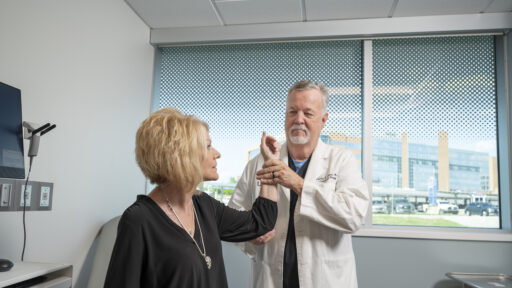Description
Foot and ankle injuries happen all the time. From sports injuries to exercise mishaps or even just taking one wrong step, these injuries can cause severe pain and mobility issues.
Many of us take our feet for granted until there’s a problem. If you have ever had a shoulder or arm injury, you can still get around despite your injury. With foot or ankle problems, getting from one room to another can be a real struggle. While surgery may be one way to correct some issues, it’s not the only way. Dr. Rob Martin talks about some non-surgical options to know and consider before going into the operating room.
Video Player
Transcript
Hi, my name is Rob Martin. I’m an orthopaedic surgeon, fellowship-trained in foot and ankle surgery, working at UAMS.
One of the things about your feet is you can’t take a step unless you have a foot that works. So patients with upper extremity injuries, you can still walk around if your shoulder hurts or if your elbow hurts. But if you have a painful foot or a broken foot, it’s impossible to get around and walk.
One of the things I tell all of my patients, the patients that I think I might end up having to operate on and even those I don’t is that I am a surgeon and I love to operate. But before I operate, we’re going to do everything that we can to make sure that we’ve tried all nonoperative modalities to get you back to a pain-free life before we consider surgery.
Probably one of the most simple nonsurgical treatments is simple immobilization in a boot walker. It’s surprising the number of patients that will come in with foot pain or ankle pain, and after a period of three to four weeks in a boot, come back to clinic pain-free and ready to go back into normal shoes. Now it’s important that you have the right type of boot walker. Depending on the foot problem, some people will just need a short boot coming up to the mid-calf region. Other patients with more significant issues may require a boot that comes up to the below-knee area.
So each patient that we see in clinic, when we come up with a treatment plan, we take several things into account. We take into account that patient’s goals for returning back to their activities. We take into account their lifestyle, as far as what activities they do on a daily basis, whether or not they’re wanting to get back to work or just wanting to be able to walk several steps again without pain. We also take into consideration other medical comorbidities, such as obesity and diabetes, which can play a significant role in the treatment of these patients.
I think the important thing for patients to understand that there’s really no problem that’s too small. Oftentimes, I see patients in clinic who just have heel pain, which can be as simple as plantar fasciitis, which is largely treated nonoperatively. And sometimes those patients leave clinic apologizing for taking my time. But my message to those people is, that’s what I’m there for.





